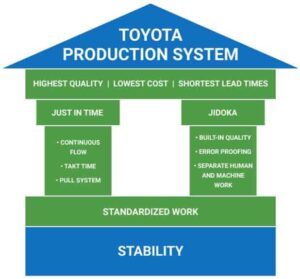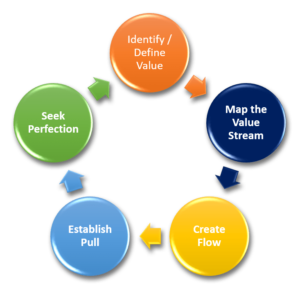Lean Thinking in Action – from Manufacturing to Compliance
- By Armand Simon
- 23 August 2023
Lean is a powerful management philosophy that can help companies improve their performance in many ways. It is based on a set of principles that can be applied to any organization, regardless of its industry or size. If you are looking for ways to save time and money, Lean thinking is a great place to start. It is based on a simple yet powerful idea: getting the most value while wasting as little as possible. Eliminating waste and improving efficiency are essential for organizations that want to reduce costs, improve quality, and increase customer satisfaction. It is not a quick fix, but a sustainable approach to improvement that can yield significant benefits over time. This article will discuss the benefits of Lean thinking and how it can be applied to compliance processes. We will also explore the challenges of applying Lean to compliance and provide tips for getting started.

To understand the history of Lean, let’s travel back in time to the beginning of modern production. Henry Ford, the pioneer who turned the world of production on its head, introduced “mass production,” a system of continuous movement of parts through the manufacturing process. It was like an orchestra, with each part playing its role in a synchronized flow. What once took hours or days could now be accomplished in minutes, thanks to this brilliant approach. Ford’s team managed to create a staggering 15 million Model T cars between 1908 and 1927.
Around 1930, Toyota also started manufacturing cars. They took a close look at Ford’s approach but soon realized that what worked for Ford’s massive operation wasn’t quite right for them. The Japanese market was a different beast—diverse and smaller. So they hatched a plan: scaling down machines to fit their actual needs and incorporating self-monitoring mechanisms. This smart move made their production faster, cheaper, and even better in quality.
This gave birth to the Toyota Production System (TPS), built on two key principles. The first, “Jidoka,” is like a safety net. If something goes wrong, the machines stop immediately, preventing any defects from sneaking through. Someone steps in to fix things, and the process can only continue if the issue is completely solved. The second principle is “Just-in-Time,” in which each process generates only what is required by the following process in a continuous flow. Nothing happens before it needs to, and everything is in sync.
Five principles of Lean
Based on TPS and the study of several manufacturing processes, Womack, Jones and Roos wrote “The Machine That Changed the World”, which was published in the early 1990s. In this book, the five principles of Lean were first introduced:
1. VALUE: Define value from the perspective of the customer.
2. VALUE STREAM MAPPING: Identify all the steps in the value stream and eliminate those that do not add value.
3. FLOW: Create a smooth flow of materials and information through the value stream.
4. PULL: Only produce what the customer needs, when the customer needs it.
5. PERFECTION: Strive for continuous improvement.

Lean is about creating the most value for the customer by eliminating waste and optimizing workflows. So it’s no surprise that other industries have adopted Lean principles as well, and with success. Top-ranked American hospital Mayo Clinic, for example, was able to lower the average wait time for a patient appointment from two weeks to two days. Bank of America employed Lean to improve the quality of its financial reporting, resulting in a 50% reduction in errors.
McDonald’s is another example of a company that has successfully implemented Lean. It has developed a highly standardized process for preparing and serving food, which allows for quick and uniform service across its many locations. If you happen to visit a McDonald’s restaurant, you will see a perfect demonstration of Lean principles in action:
PULL: Instead of pre-making sandwiches that might sit for a while, the process only begins when you place your order. This guarantees that your sandwich is served freshly prepared, tailored to your specifications, and minimizes excess food production that could lead to waste.
FLOW: By focusing on a smaller number of popular options, the kitchen crew can operate more efficiently, resulting in faster and more precise order fulfillment. This technique eliminates complexity while increasing service speed and precision, benefiting both customers and operational flow.
Lean Thinking in Compliance Processes
So how does this apply to compliance? Isn’t the compliance sector fundamentally different from the manufacturing industry?
 Compliance is characterized by its own processes, complexities, and potential for inefficiencies. Just as Lean seeks to eliminate waste and optimize workflows in manufacturing, it can also be harnessed to streamline compliance processes, enhance transparency, and minimize errors.
Compliance is characterized by its own processes, complexities, and potential for inefficiencies. Just as Lean seeks to eliminate waste and optimize workflows in manufacturing, it can also be harnessed to streamline compliance processes, enhance transparency, and minimize errors.
In Lean, the concept of “waste” refers to any activity that does not add value to the end product or service. Let’s examine an important element of compliance: validation. A compliance audit does not add any value to a service or product. Compliance audits are resource-intensive processes that take time, effort, and often financial investment to gather and present documentation, answer to inquiries, and implement recommended improvements. Furthermore, audits frequently require employees to shift their focus away from their regular tasks in order to meet audit requirements, thereby creating short-term productivity declines. So, can we conclude that compliance audits should be considered as “waste”?
It is absolutely true that validations do not directly contribute to the creation of a product or service. However, they are a systematic and independent examination of an organization’s processes, practices, and operations to determine whether they align with the established compliance requirements. Validations help to prevent potential waste that may arise from non-compliance, such as legal complications, fines, and reputational damage. As such, compliance audits are not typically considered as “waste” in the context of Lean.
There are some fascinating statistics to be found if we dig a little deeper. According to a Harvard Business Review research , Lean principles can reduce the time it takes to execute a compliance audit by up to 50%. This should be music to the ears of those who dread this periodic ritual. But there are more benefits.
BioPharm International conducted a study in 2020, surveying fifty pharmaceutical companies that had implemented Lean principles. This study found that these companies were able to reduce their compliance expenses by an average of 30%. They were also able to improve the quality of their compliance programs by reducing the number of compliance violations.
 The Dutch Central Bank (DNB) is the central bank of the Netherlands. In 2018, DNB began a Lean initiative to improve its compliance with Basel III capital requirements. The initiative focused on reducing the time and effort required to collect and analyze data, as well as improving the accuracy and completeness of data. As part of the initiative, DNB implemented a number of Lean principles, including value stream mapping, flow, and pull. Value stream mapping helped DNB to identify and eliminate waste in its compliance processes. Flow was used to create a smooth and efficient flow of work through the compliance process. Pull was used to ensure that only the work that was needed was performed. The results of the Lean initiative were significant. DNB was able to reduce the time it took to collect and analyze data by 20%. It also improved the accuracy and completeness of data by 10%.
The Dutch Central Bank (DNB) is the central bank of the Netherlands. In 2018, DNB began a Lean initiative to improve its compliance with Basel III capital requirements. The initiative focused on reducing the time and effort required to collect and analyze data, as well as improving the accuracy and completeness of data. As part of the initiative, DNB implemented a number of Lean principles, including value stream mapping, flow, and pull. Value stream mapping helped DNB to identify and eliminate waste in its compliance processes. Flow was used to create a smooth and efficient flow of work through the compliance process. Pull was used to ensure that only the work that was needed was performed. The results of the Lean initiative were significant. DNB was able to reduce the time it took to collect and analyze data by 20%. It also improved the accuracy and completeness of data by 10%.
The DNB case study is a good example of how Lean principles can be applied to the compliance sector. The initiative resulted in significant improvements in efficiency and effectiveness, which helped DNB to better comply with the Basel III capital requirements.
Getting started with Lean
To get started with Lean, you need to identify key areas where waste can be eliminated and workflows streamlined. You can do this by conducting a comprehensive review of your current processes and exploring how Lean thinking can be applied. Once you have identified areas for improvement, you need to develop an implementation plan. This plan should include specific goals, objectives, and timelines.
Here are some additional tips for applying Lean principles to your organization:
- Start small and focus on one process at a time
- Be patient and persistent. It takes time to implement Lean principles and see results
- Celebrate successes along the way. This will help to keep employees motivated and engaged in the process
If you are not sure where to start, just get in touch with us. Our experts will work with you to develop a plan that’s right for your organization and help you achieve operational excellence.
- Armand Simon
- 23 August 2023
References:
1. The Machine That Changed the World, by Daniel Roos, Daniel T. Jones, and James P. Womack, published in 1990
2. The Lean Approach to Compliance” by Michael Ballé, published in the Harvard Business Review in 2015
3.”How Lean Can Help Reduce Costs and Improve Compliance Simultaneously” by BioPharm International, published in 2019
4.”Lean Thinking in the Compliance Function: A Case Study of the Dutch Central Bank” by Arjan van der Vegt, Jeroen van Heemskerk, and Mark Tummers, published in the journal “Public Management Review” in 2020
